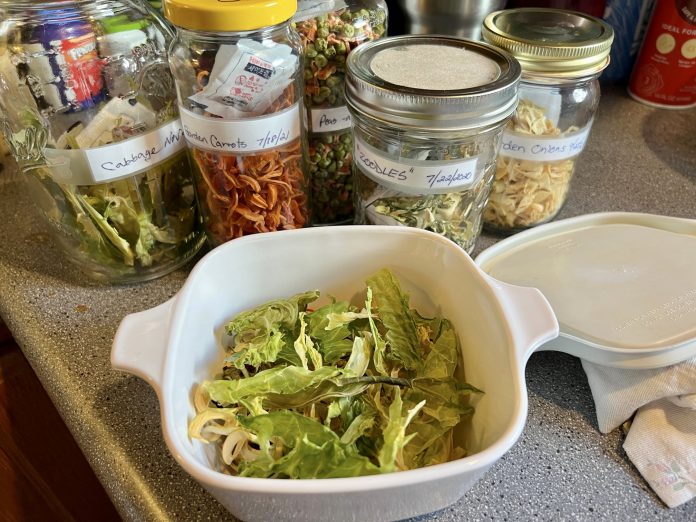
You are probably sick unto death of food articles from me. But here’s the thing – food keeps you alive. Without it – you die.
I’ve talked and talked (and talked) about growing food, preserving food, and storing food. But I haven’t talked an awful lot about how to USE the food that you have stored in your shelf stable supplies.
Forgive me if this post sounds a bit too basic and “Mom-ish”, but my concern isn’t for those who have loads of cooking experience on campfires and backpacking stoves and who fend for themselves in the kitchen department every day. My concern is for those (especially young people) who are like the woman in Texas who posted on social media during the winter storm and blackouts last year asking if there was any fast food open because she had nothing to eat at home.
Assuming that at least some of you are of the persuasion who live by take-out, Door Dash, and the microwave I thought it might be useful to provide some mom-ish, simple (or just plain frugal) recipes to make at home from your shelf-stable food stash.
Supplies/Tools
Because in a grid down situation you will have to cook sans microwave over a flame of some sort – be it camp stove, Sterno, etc – and because you can’t cook over flame with plastic, I’m going to assume that you have at least the basics like a skillet, a pot, a few heat proof utensils. I’ll also assume that you have some some basic staples and spices like cooking oil, dried onion flakes, garlic powder, salt, pepper, soy sauce, taco seasoning, etc – is that a safe assumption?
If not, then some of you need to step up to the adulting table and get yourself these things. You can find utensils and pots/pans cheap at second hand stores, the dollar store, or even your grandmother’s basement. Fancy and “matching” are not required. You’ll get no judgement from me. I’m still using mixing bowls and a few utensils that came from my grandmother’s kitchen when she passed away in 1986.
The Basics
I’ll also assume that you know how to do the basics like boil water, and scramble an egg, right? If not, you need to do some adulting again and get on YouTube and teach yourself a few kitchen skills BEFORE the grid goes down. These are things you should have learned before you ever left home, so if you didn’t, you need to do some catch up.
What follows are not truly “recipes”. They are more like assembly instructions and ideas for using various components of your shelf stable food stash. You can spice them up as you wish.
Nutrition
It’s also important to think about nutrition here. You may make it a few weeks or months just on beans and rice, but you’ll likely need to take a multivitamin in order to stave off nutritional deficiencies. Planning on adding fruits and veggies to your daily cooking will help keep you healthier longer even if the world around you is in chaos. Scurvy is not just for British sailors and pirates.
Fiber
In addition to staving off nutritional deficiencies, fruits and veggies provide dietary fiber which helps to keep the GI tract moving. If there is an emergency and you have to use other than the usual sewage system for waste disposal, you want to get the deed done and over with quickly. You don’t want to have to sit there in a makeshift latrine for half an hour while expelling a brick. Is that TMI? Well sorry, but I’m a doctor, remember? These things are important considerations. I’m sure some of you have deployment tales to tell …
Carbs
Let me say a word about carbs here. Rice, Potatoes, Pasta and other carbs have become “the devil” in our modern overweight keto-dieting society. But in an extended emergency those carbs mean life-sustaining calories in addition to being fortified with basic nutrients like thiamine and riboflavin. Calories keep you alive. Rice and noodles are an excellent meal extender if you need to stretch your supplies to accommodate more people. (Or make meager supplies for one person stretch for more days.) So do not hesitate to serve your chili over rice, your beans over rice, your scant meat and veggies in gravy over noodles or mashed potatoes, and your tomato and meat sauce over spaghetti (obviously) – you get the idea. There is a reason our grandparents and great-grandparents ate the way they did. Potatoes also kept entire populations alive in previous centuries. In a grid down situation carbs are your friend. Utilize them accordingly.
Fats
Let me say another dirty word in today’s dietary lexicon – fats. Many people do not have enough fats stored in their shelf stable supplies. In addition to being an essential for stir frying, sautéing, and being a general flavor vehicle, fats are concentrated calories. You are going to need something to do actual frying with – in an actual frying pan. Olive oil, ghee, Crisco, lard, bacon drippings – all of it has a use in grid down cooking and keeping up your caloric intake. If the weather is cold you are going to be burning calories to keep warm. If you are bugging out, you need calories to keep up your mileage pace on foot. Even if you are “bugging in” you may be doing more physical labor than usual for clean-up after a disaster, or building fortifications for a man-made disaster. Labor requires calories. Fats provide them.
So with all that said let’s talk about a few ways to assemble your shelf stable foods into meals.
Fried Rice
Fried rice is in regular rotation in my weekly food prep routine even in a non-emergency. I make fried rice often and freeze individual portions for work lunches. I use my home dehydrated homegrown veggies for this. In an emergency you can use canned veggies, but pour off the juice and save it to cook the rice with. There is nutrition in that juice that you don’t want to waste, plus it will save your fresh water supply.
While I used the last of my home dehydrated chopped onions with this last batch, you can also use store bought dehydrated onion flakes which keep on the shelf for years. Use fresh eggs if you have them, otherwise, try out that package of Mountain House scrambled eggs you’ve been hoarding or open that package of dehydrated egg crystals. Eggs “make” fried rice and they add protein to an otherwise vegetarian dish. You can add canned meat if desired (I often use my home canned turkey), or leave it vegetarian and garnish with some nuts for extra protein.
Directions: Start cooking rice ahead of time per package directions (Usually half the amount of rice as water – for instance 1/2 cup of rice to 1 cup of water or saved canned veggie juice.) Bring rice and water (and salt and a dab of oil) to a boil and simmer covered for about 15 minutes until all the water is absorbed. Set aside.
To rehydrate dehydrated veggies, I pour boiling water over them in a heat proof bowl til the water covers the veggies. Stir, cover and set aside for 5-20 minutes depending on how big/thick the pieces are. You can do this while you are boiling water to cook the rice with. In a large frying pan heat your cooking fat of choice and stir fry the veggies you are using (onion, garlic, peas, carrots, cabbage, zucchini, green beans or whatever you have). Toss in a small amount of canned meat if you are using it and stir fry to heat.
Add a little more oil, and then put in the cooked rice and sauté some more. Add whatever spices you are using – soy sauce, ginger, garlic powder etc.
Push the mixture out to the sides of the pan and in the center add whatever eggs (2 to 3) you are using – fresh or liquified dehydrated eggs. Cook/scramble the eggs in the center of the pan, then gradually stir into the rest of the mixture. Add additional seasoning to taste and then eat.
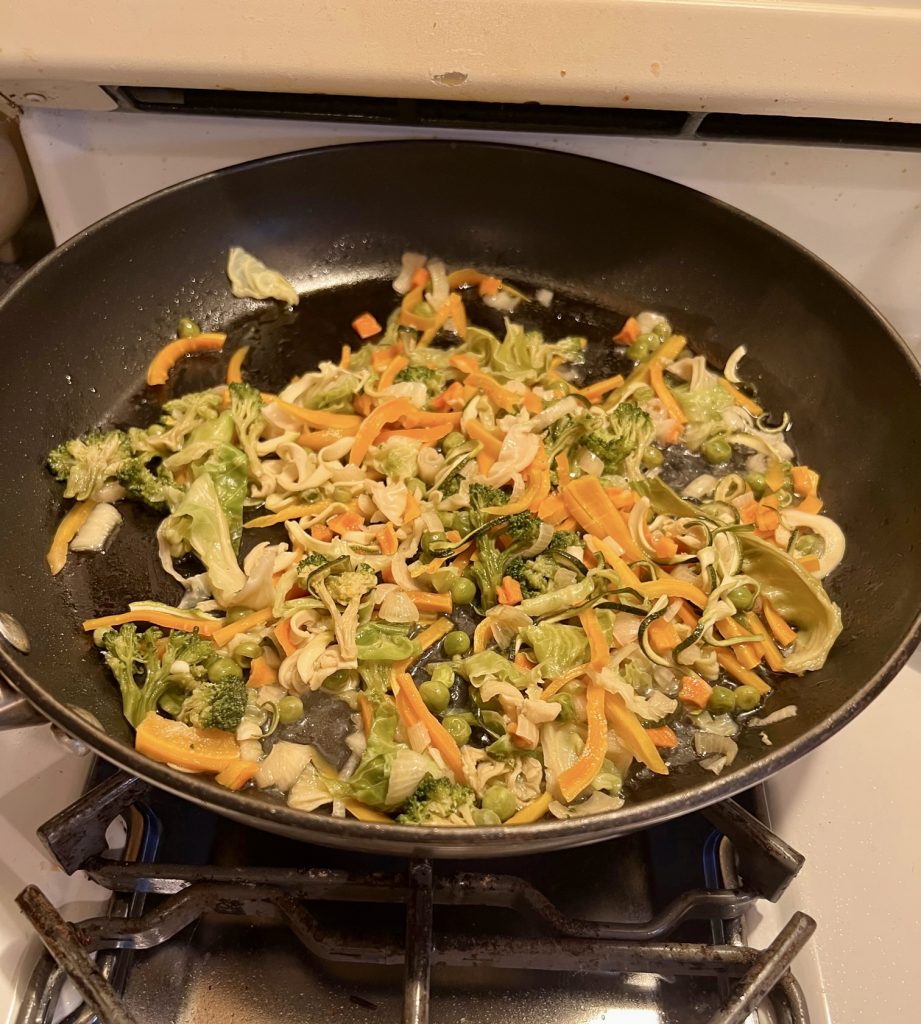
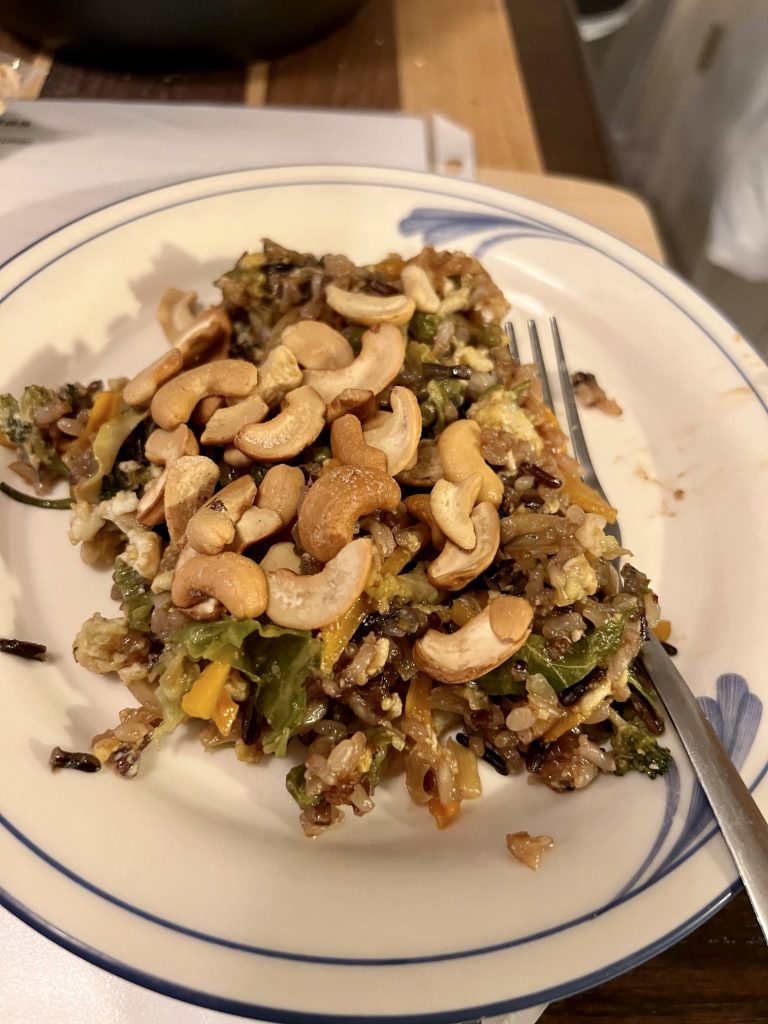
Southwest Skillet Meal
You can assemble this pretty much the same way as the fried rice. You can use cans of (drained) beans and corn, dehydrated tomatoes if you have them, taco seasoning, rice (or pre seasoned packet of yellow rice/Spanish rice/taco rice, etc). You can add a can of “fajita beef”or not as you prefer. Eat it all wrapped in tortillas if you have them, or straight out of the pan.
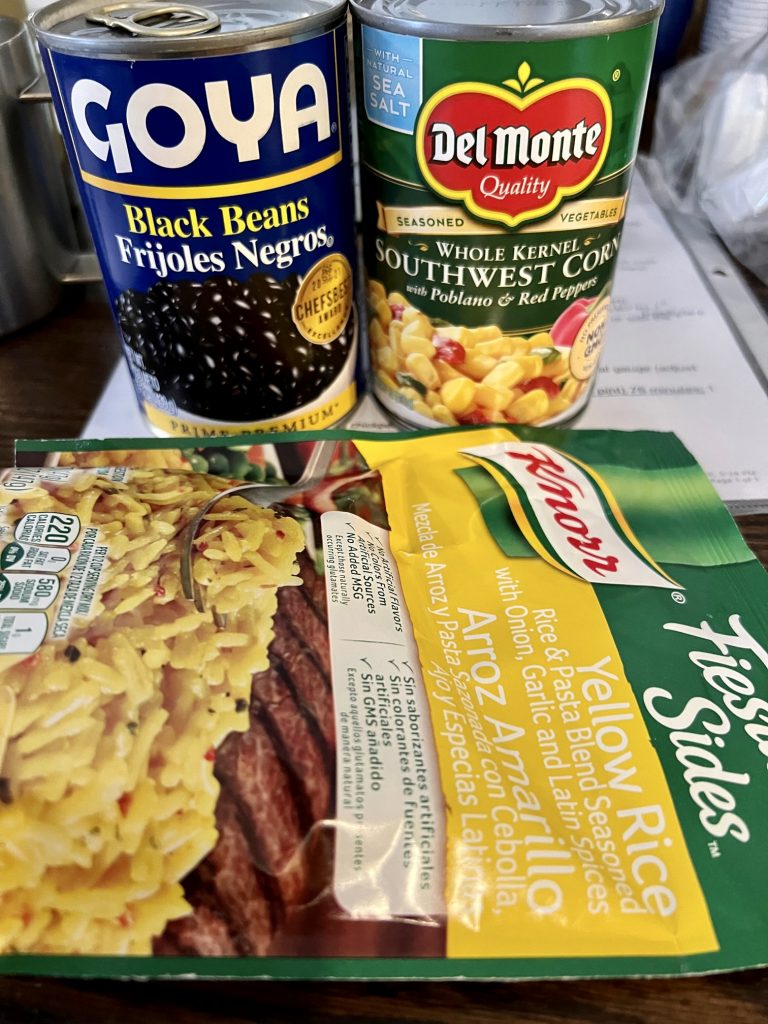
Fried Spam and Potatoes
You can used dehydrated potatoes or canned potatoes for this. Here is another place to use your bulk canister of dried onion flakes – or wild onions if you can find them in your yard. I personally would also throw some of my dehydrated shredded zucchini or spinach in with this for extra veggie power. At this time of year you can even go pull up some newly sprouted dandelion leaves and red clover from the yard and toss that in to the sautéed mix also for some extra nutrition.
Directions: If you are using dehydrated potatoes you will need to boil water to rehydrate them about a half hour ahead of time. Same too for any dehydrated veggies. I love shredded potatoes, tomatoes, and zucchini for this because the small pieces rehydrate so quickly.
Put your fat of choice in the skillet, fry the cubed up spam first to brown it a bit, then add the potatoes with onions and whatever veggies and spices and fry for five minutes or so depending on how small your pieces are. Eat.
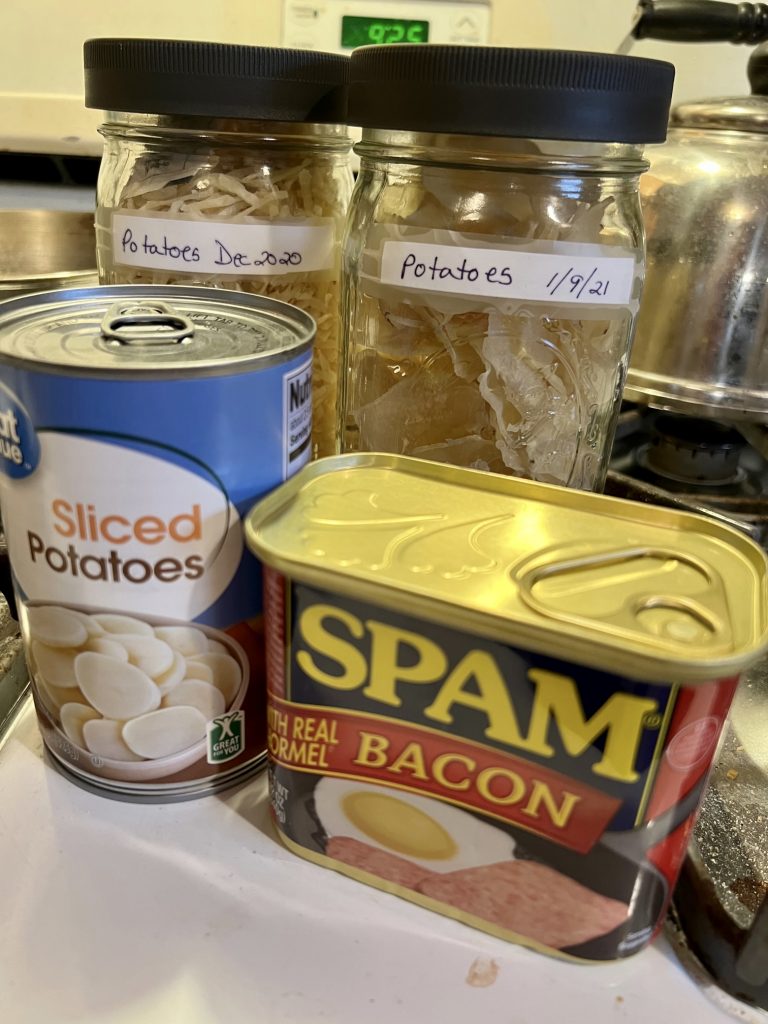
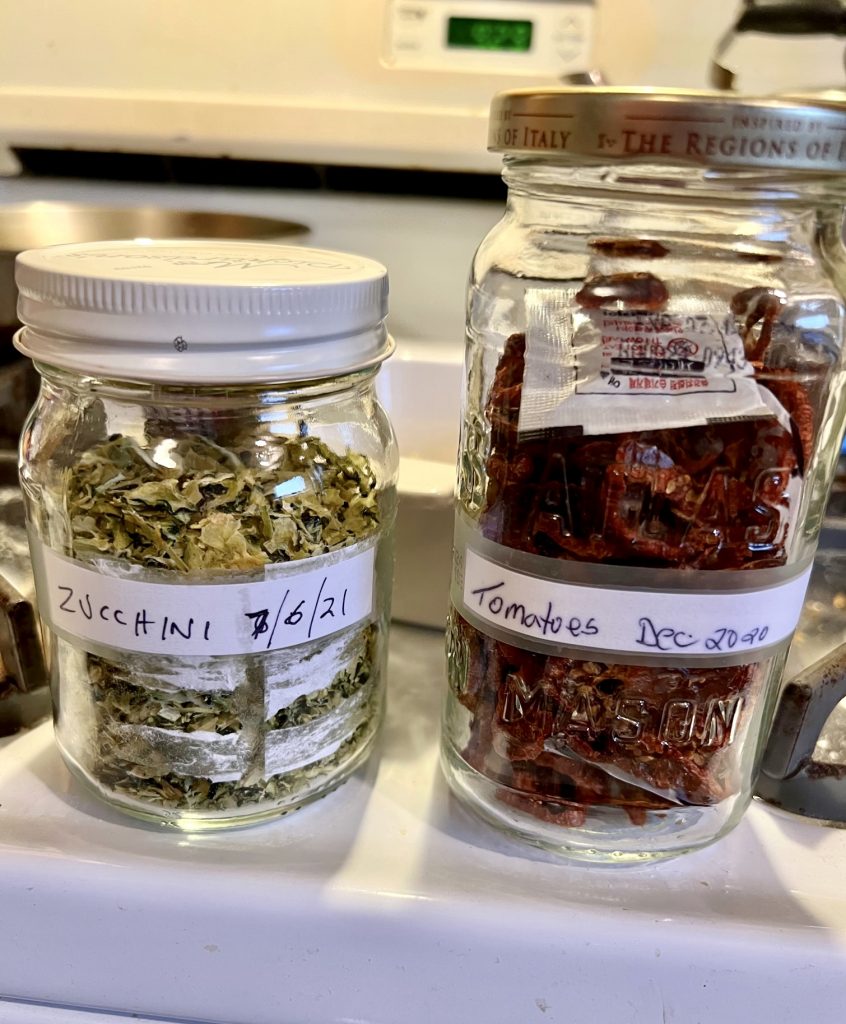
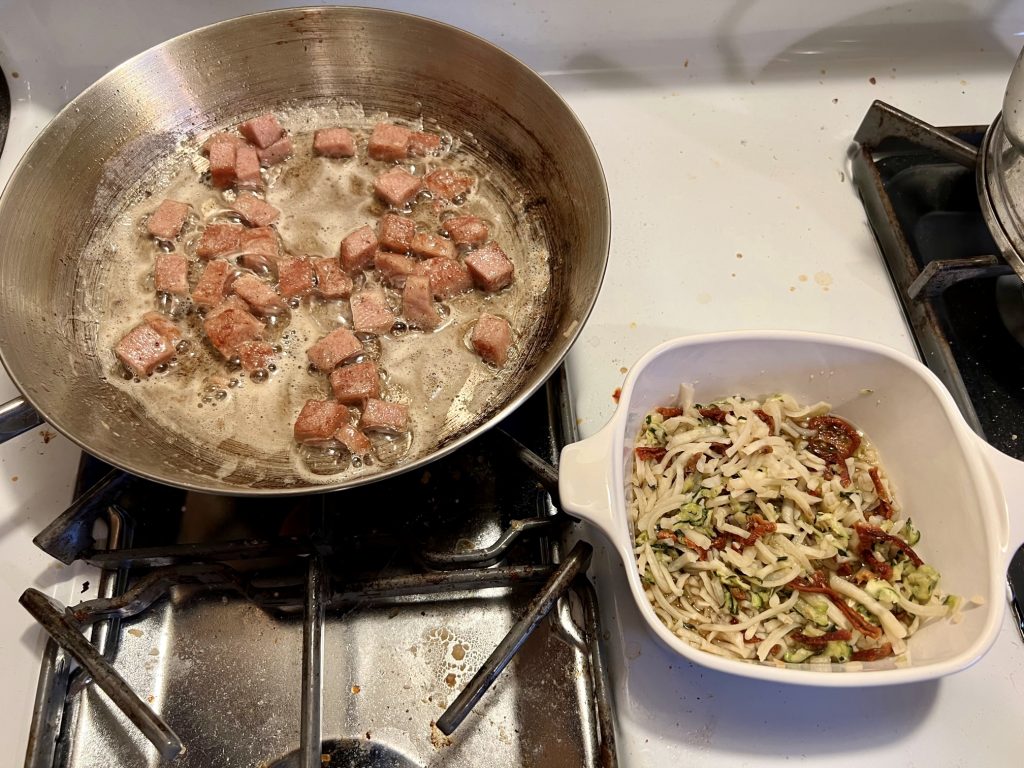
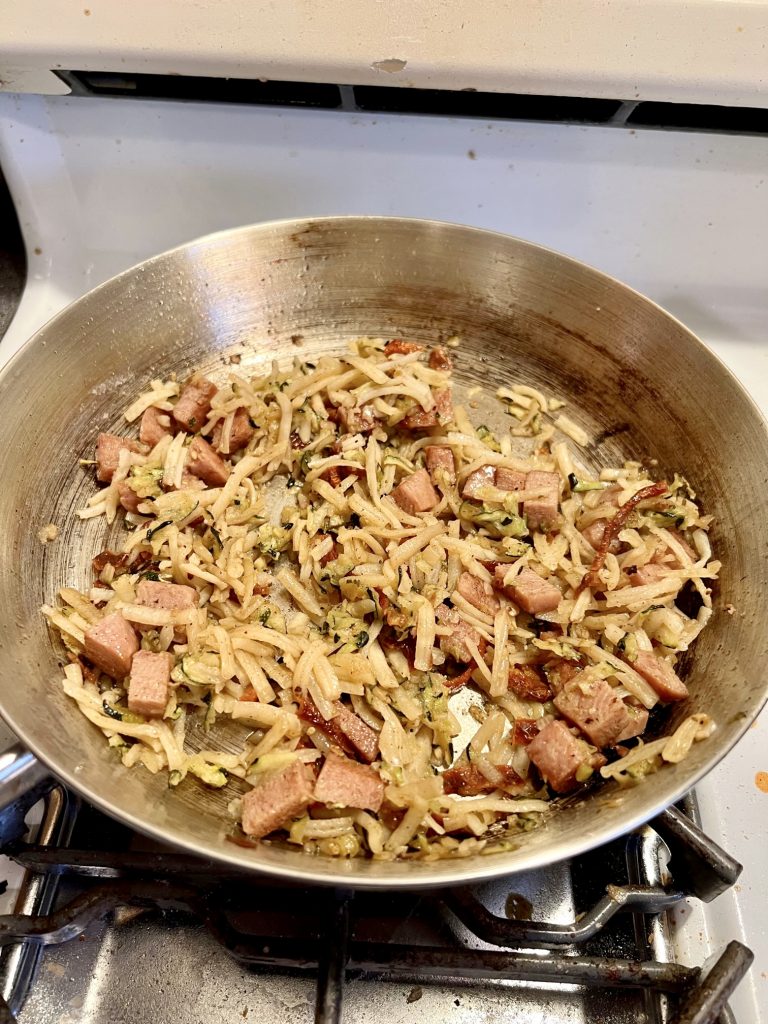
Cheesy Potato Soup
I made this as an experiment using a package of dry mashed potatoes, some of my home dehydrated potatoes for texture, some ham flavored bouillon, some spices, a can of table cream, and a tablespoon or two of “Big Daddy” cheese powder. I was blown away with how good it turned out! You could even make this with some canned clams or canned baby shrimp to make a chowder or “seafood bisque” or anything else for variety. The point is – it can be done, and it can be tasty even though it came from shelf foods. I didn’t have a recipe, I just made a plan in my head and went with it. I also tasted as I went along and added what I thought it needed.
Directions: Boil enough water to rehydrate your potato cubes, your mashed potatoes, and to make some broth besides to thin it out. You will have to play with this depending upon how big a batch you want. Basically you are dumping it all together, adding spices and cheese powder, and your canned cream at the end and cooking it for maybe 30 minutes to let the flavors all blend and finish rehydrating your taters. It’s not difficult – it’s soup after all – but you may have to play with it a bit to get it how you like it.
I need to stop and say a word about this cheesy Big Daddy powder I got from Hoosier Hill Farm at the beginning of the pandemic. I originally got it to go with the case of rotini I ordered from Amazon. While I ultimately decided that I preferred to buy Mac and cheese boxes with the pouch of plastic cheese to obviate the need for fresh milk and butter, this powder is a great flavor booster for potato dishes, dehydrated broccoli, etc. I know it’s not “real” cheese, but when we are eating non-refrigerated food in an emergency, the extra flavor of something tasty really helps the mental and emotional outlook.
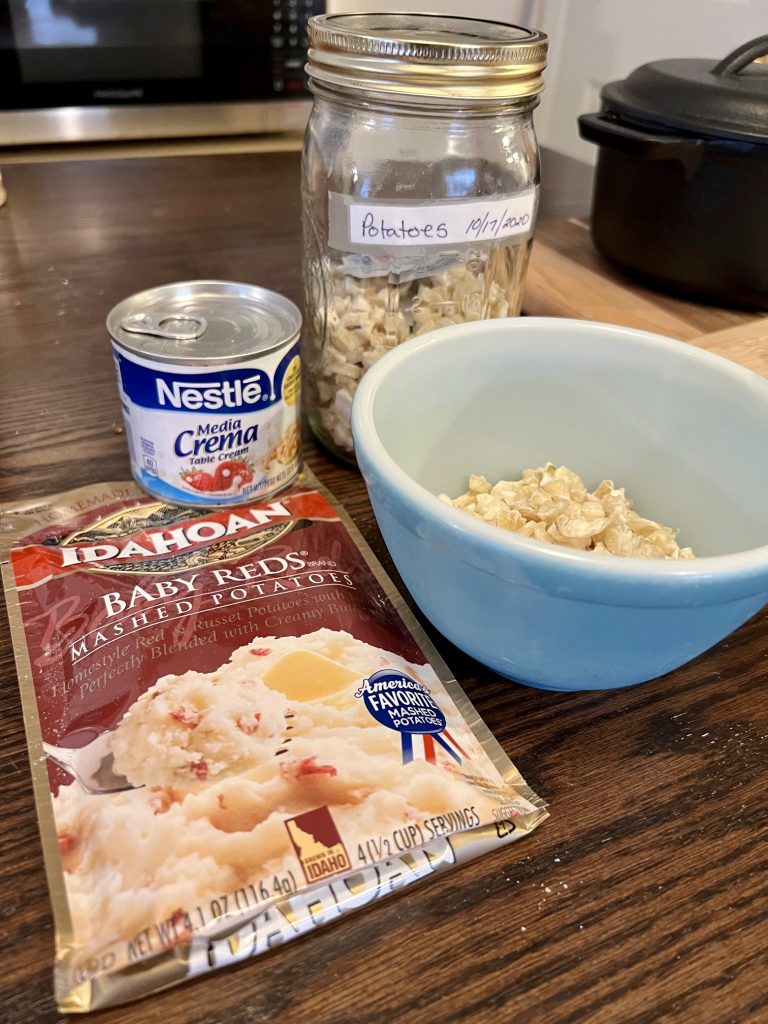
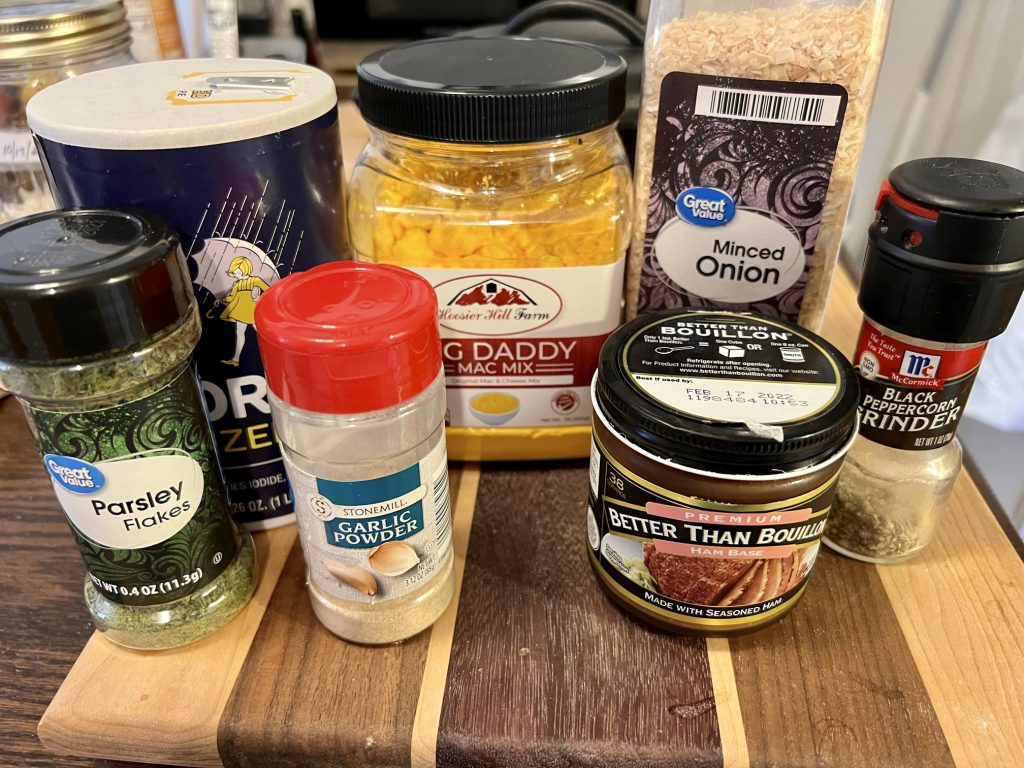
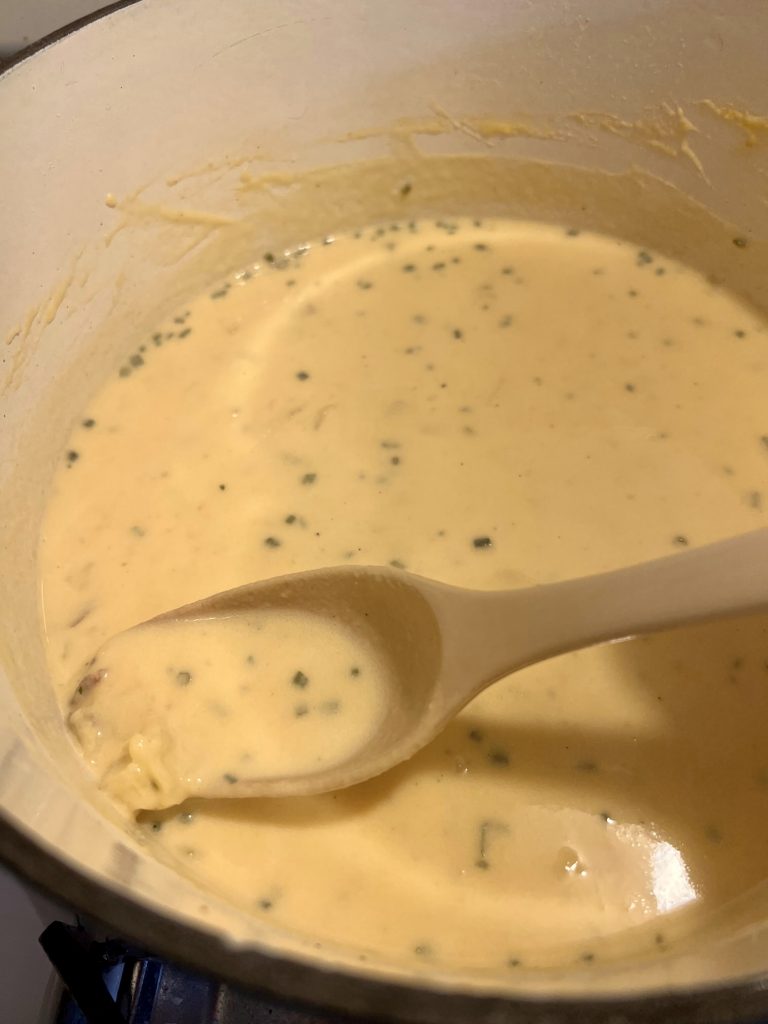
Fried Spring Greens and Noodles
This is a variation on Eastern European Haluski. I recently pulled up the last of the cabbage I planted last fall -it never made full heads and looked like it was getting ready to go to seed – so I decided to eat it instead. I added one of my last garden onions that was hanging in the basement and I threw in some dandelion greens and some wild onion/garlic that I pulled from my gravel driveway. It’s easy – just cook and drain some noodles ahead, then sauté the greens and onions in butter, bacon grease, or oil, spice to taste, and serve over the cooked noodles, or just stir the noodles into the pan. With or without some crumbled bacon or diced spam it is delicious. The noodles give you carbs/energy, the greens give you vitamins and minerals, and you get some protein from the bacon or spam.
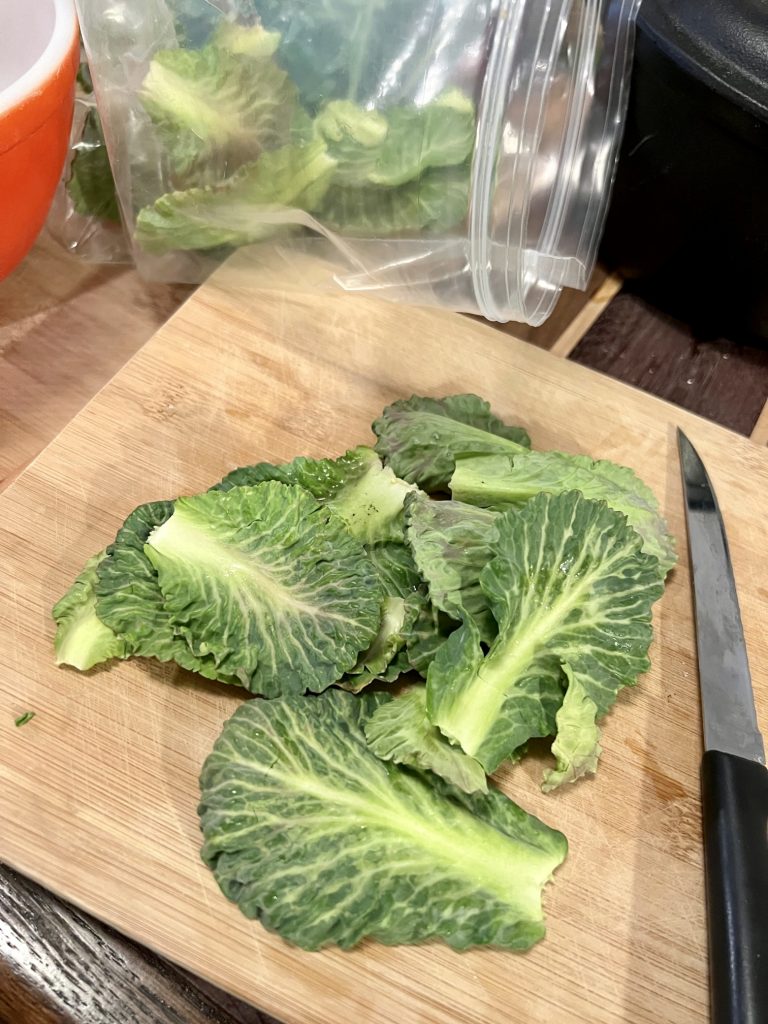
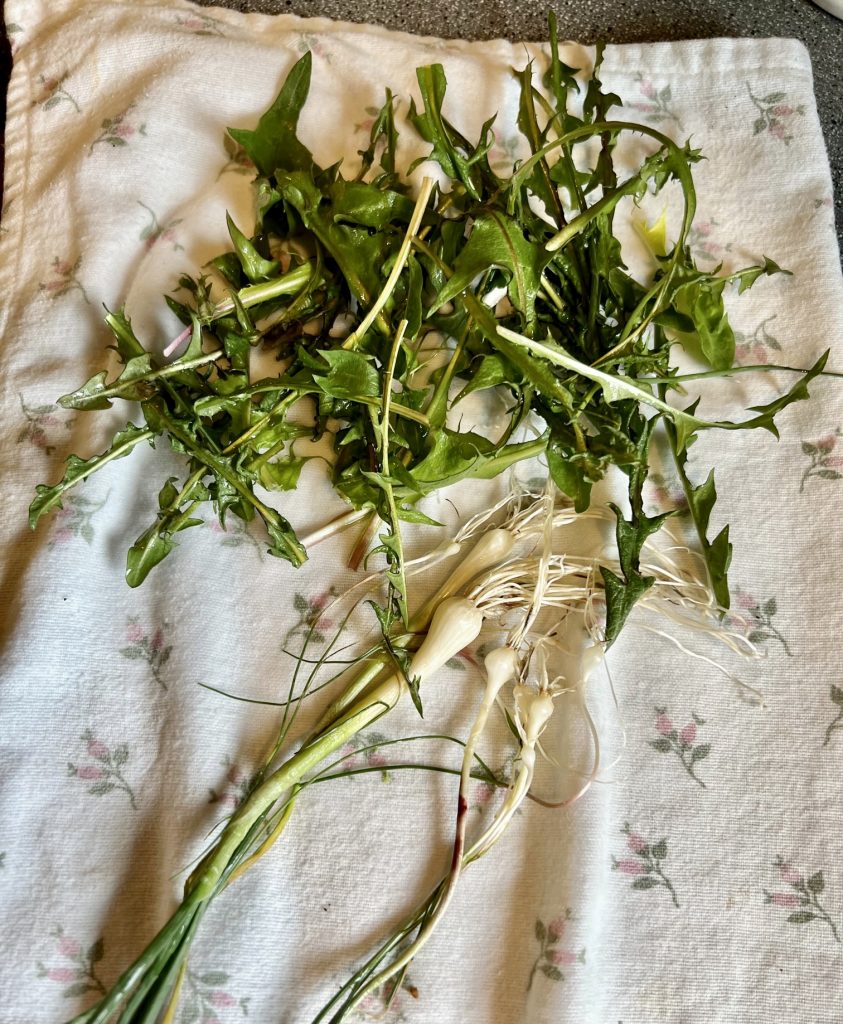
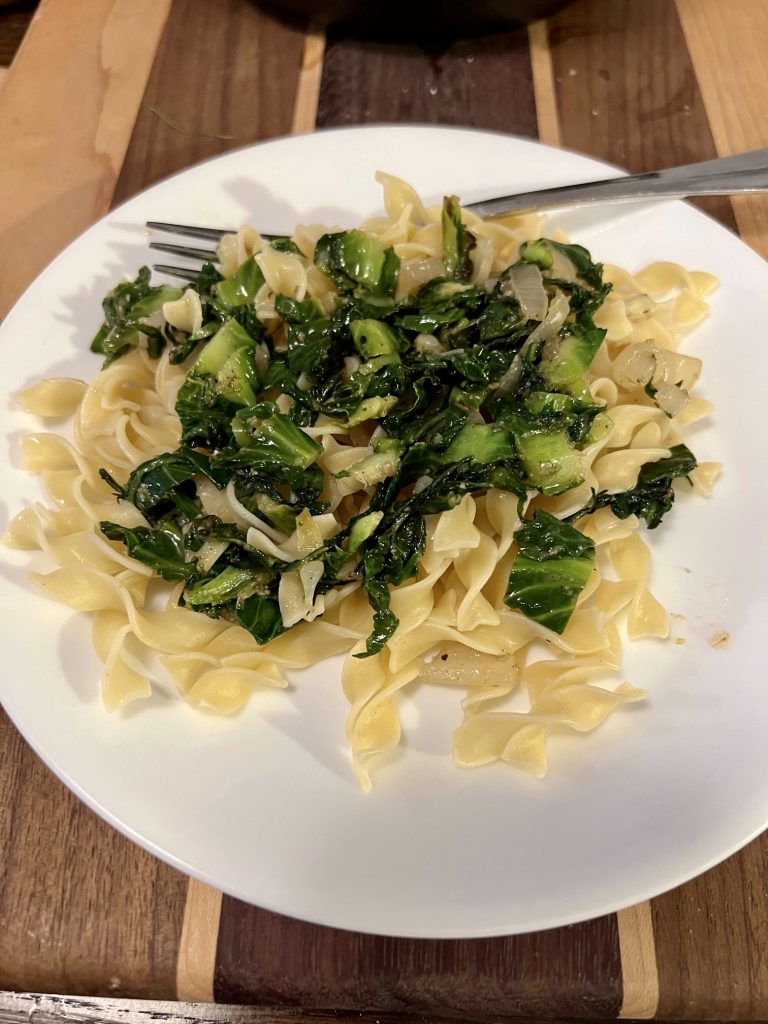
“Goulash”
This is a generic term for almost any combination of meat, tomatoes, vegetables and macaroni. Virtually everyone in middle America has a family goulash recipe and either loves or hates it. Even if you hate it this is a good and easy one pot meal that you can make with shelf stable food. Again, I’m not offering specific recipes but merely assembly options for what you already have. You need a can of some sort of meat, a can or two of veggies, maybe a cup or two of cooked elbow macaroni (or noodle of choice) some dehydrated onion and spices, and a can of tomatoes or even tomato soup. Assemble as desired. Add some canned or powdered cheese if you have it.
Portions and Leftovers
A word about portion sizes. For those of you with large families, you likely already know how to cook and in what proportions to do so. So this is more for the singletons out there who don’t cook much.
Granted, cooking for one can be challenging. But not if you use your head a little. When I’m cooking for myself everyday I routinely cut a recipe in half before I even turn on the stove. On the other hand I also often make a standard size recipe and freeze it in individual portions for work lunches.
Food Safety
The real challenge will come with a grid down situation. What do you do with leftovers that you can’t freeze? Especially in warmer climates food poisoning is a real risk. For food safety per the CDC, leftovers need to be kept above 140F or below 40F. This is where there is a huge advantage to having dehydrated veggies and such. You don’t need to use up a whole can of whatever. You can just measure out a handful what you need for a single serving and leave the rest dehydrated in the jar. Dump out your veggies, tomato powder, squash powder, onion flakes etc – plus however much loose pasta or rice. Cook only what you need and no leftovers. Ta-da!
If you do have leftovers and it’s wintertime and cold you are golden. Just put the leftovers outside the door in a sealed container. Putting it on an outside elevated balcony might be even better if you have neighborhood animal problems. Or fill a cooler with snow and use that as your “refrigerator”. Our ancestors used spring houses to keep things cool, but unless you have running water on your property that likely isn’t an option.
Vacuum Bottle
Another option I want to try out for an emergency is to use a wide mouth thermos jar. I bought a couple to try. My thought is that I could cook the main meal at midday, then put the leftovers in a wide mouth vacuum bottle to keep them warm until supper time. Then I’d just eat out of the thermos for a second meal. It would theoretically save on fuel, as though I might need to heat water for coffee or tea (or not if I used a second thermos), I wouldn’t need to cook an entire meal for a second time that day and wouldn’t need to start another fire or light up the grill again. I need to set aside a weekend to try out this idea and see how it goes. It shouldn’t be any different than carrying a hot lunch to work. I just need to see how long the hot food stays hot (and safe).
It would be nice if we all had a group of friends to gather with during hard times to share the burdens and supplies. We wouldn’t have to cook by ourselves and for just one that way. But a core zombie fighting group might take some time to assemble. So cooking for one – at least temporarily for short term emergencies – should be a consideration. If you plan for it ahead of time (and acquire the skills) it shouldn’t be a big deal.
In the meantime these few “recipes” will give you a place to start if you want to learn to cook for yourself with your shelf stable foods. With the way inflation is going many people would be wise to learn to cook at home anyway. It’s major dollars cheaper than paying for take-out or door dash. It will also give you some practice in case something bad happens and you need to do it “for reals”. Bon Appetit!



